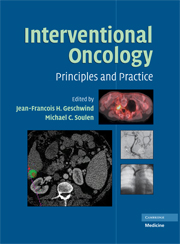Book contents
- Frontmatter
- Contents
- FOREWORD
- ACKNOWLEDGMENTS
- CONTRIBUTORS
- PART I PRINCIPLES OF ONCOLOGY
- 1 Biology of Cancer
- 2 Evaluation of the Cancer Patient
- 3 Principles of Chemotherapy
- 4 Pharmacologic Principles of Regional Therapy in the Treatment of Liver Metastases or Primary Liver Tumors
- PART II PRINCIPLES OF IMAGE-GUIDED THERAPIES
- PART III ORGAN-SPECIFIC CANCERS
- PART IV SPECIALIZED INTERVENTIONAL TECHNIQUES IN CANCER CARE
- INDEX
- Plate section
- References
3 - Principles of Chemotherapy
from PART I - PRINCIPLES OF ONCOLOGY
Published online by Cambridge University Press: 18 May 2010
- Frontmatter
- Contents
- FOREWORD
- ACKNOWLEDGMENTS
- CONTRIBUTORS
- PART I PRINCIPLES OF ONCOLOGY
- 1 Biology of Cancer
- 2 Evaluation of the Cancer Patient
- 3 Principles of Chemotherapy
- 4 Pharmacologic Principles of Regional Therapy in the Treatment of Liver Metastases or Primary Liver Tumors
- PART II PRINCIPLES OF IMAGE-GUIDED THERAPIES
- PART III ORGAN-SPECIFIC CANCERS
- PART IV SPECIALIZED INTERVENTIONAL TECHNIQUES IN CANCER CARE
- INDEX
- Plate section
- References
Summary
ANTI-NEOPLASTIC AGENTS
The pharmacological approach to chemotherapy encompasses a wide number and many types of medications. Classically, cytotoxic agents that target rapidly dividing cancer cells have been the mainstay of treatment. More recently, the use of agents that target the immune system (immunotherapy), the biological pathways of malignant cells (targeted therapy) and the hormonal environment of the cancer (endocrine therapy) have been developed to use as single agents and in combination with other anti-neoplastic agents. This chapter overviews the common classes of antineoplastic agents and discusses some of the most common related toxicities. A more extensive review of these agents is available in many texts (1–3) and in published reviews. A quick reference list of toxicities for specific agents is available (4) and delineates between acute and delayed toxicities.
Agents used as cancer therapy are commonly categorized by mechanism (e.g., anti-metabolite or tyrosine kinase inhibitor) or origin (e.g., vinca alkaloid). Within a specific class of agents, the drugs differ significantly in pharmacology, activity and clinical application. Toxicities are often unique to an agent within a class, and the manifestation of a drug-induced side effect may vary significantly based on the drug dose, schedule, route of administration and drug therapy combination. Additionally, the tolerability of most drugs used in the treatment of cancer depends upon numerous aspects of an individual. Factors such as disease, organ function (e.g., renal function, liver function), comorbidities and concomitant medications impact toxicities and pharmacology of many agents.
- Type
- Chapter
- Information
- Interventional OncologyPrinciples and Practice, pp. 28 - 37Publisher: Cambridge University PressPrint publication year: 2008



